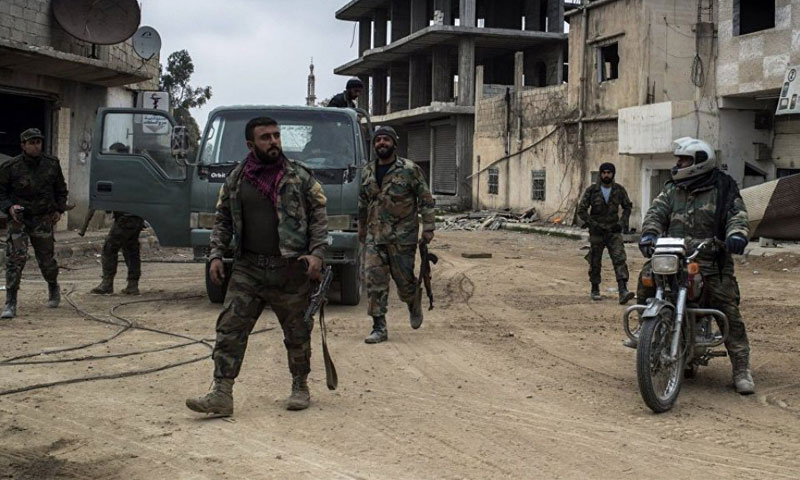



Iran has continued its attempts to expand in the Syrian south, despite the international agreements that have limited its role in the region. The last was the Russian-American agreement that stopped the fighting in Daraa and withdrew the Assad’s forces and foreign and local militias supporting them from the Jordanian border.
The influential countries in southern Syria regard the arrival of the Iranian militias to the Syrian-Jordanian borders and the borders with the occupied Golan as a “regional red line”, which necessitated direct interventions that failed to curb expansion attempts due to Iran’s manipulative methods in the past a few months.
In June 2017, western officials leaked a document showing the US-Russian-Jordanian talks, which resulted in an agreement on a tripartite memorandum of understanding, including the principles, needed for the formation of a safe zone in southern Syria.
The officials said that the agreement stated that there should not be non-Syrian forces in a 30 kilometers deep enclave near the Jordanian borders, in a reference to Lebanese Hezbollah, a Shi’a Islamist political party and militant group based in Lebanon, and Iran-supported militias.
In the past a few days, Daraa has witnessed a serious competition between Iran and Assad’s forces over the recruitment of the governorate’s young people. Everything about this competition is surprising, the timing, the means and the location; and the first of its results was the formation of Brigade 313 under Iran’s Revolutionary Guard.
Safwan al-Jamaat, one of the people who joined Brigade 313 before fleeing to opposition-held areas, said that the recruitment process in the new formation targeted those wanted for compulsory and reserve service in the Assad’s forces in particular.
He told Enab Baladi that the people enrolled in the Brigade because they feared to be sent to the hot fronts in other governorates. Joining the Brigade allows them to stay in Daraa and stops Assad’s forces from persecuting them.
Despite the fact that the Iranian brigade has been formed only a few month ago, it has attracted more than 200 young people.
Al-Jamaat explained that the people who are enrolling in the Iranian formation are from Daraa and that they are known for working for the Syrian regime; currently, they are promoting the Brigaded depending on the privileges it is providing and the amounts of money it is giving to the participants.
As for Iran’s recruitment mechanism, the former recruit explained that all those he met were Syrians, but they consistently confirmed that the formation was directly under the leadership of the Iran’s Revolutionary Guard.
Enrolment takes place at the headquarters of Brigade 313 in the city of Izra. The recruit receives a card that carries the logo of the Revolutionary Guard, which guarantee him the ability to pass Assad forces’ checkpoints.
Two weeks later, the recruit joins a training camp in Izra and al-Shaykh Maskin.
Al-Jamaat explained that those who are responsible for the new formation keep talking about “the successful experience of the Lebanese Hezbollah,” for they are aspiring to repeat this experience in a new form in the Syrian south.
As for the opposition, the factions do not care about the new Iranian step in the south. Yousef al-Zu’bi, a field commander in Jund Mohammed Brigade (Mohammad’s Soldiers) of the Free Army, considered that the confrontation with Iran is a reality now, whatever its name may be.
“There is no difference between one enemy and another, whether it is the Syrian army, Hezbollah, the Revolutionary Guard or any of the dozens of foreign militias,” he told Enab Baladi.
On the Iranian focus on the recruitment of the sons of Daraa in particular and involving them in a confrontation with the people of their governorate, the commander said to Enab Baladi that anyone who fights alongside Assad’s forces “is a traitor, no matter what nationality or origin he has.”
He explained that the opposition’s factions had previously faced fighters from Damascus, Idlib, Homs and other Syrian regions, “All [these fighters] belong to revolutionary regions […] they represent themselves and do not represent these areas at all. The thing will not change if we faced someone from Daraa, and we will not hesitate in fighting him.”
As for the steps which the opposition is supposed to take to limit the Iranian expansion in the current period, the commander said that, in the meantime, they are committed to the de-escalation agreement and the truce in southern Syria and that they are relying on the regional role in that context.
The futuristic scenarios are, according to the commander, confined to the military option only if the political solutions fail to stop the Iranian ambitions in Syria in general and the South in particular.
The massive security observation and the random arrests by Assad’s forces seeking to recruit people from Daraa forced hundreds of young people to take refuge in the opposition-held regions or to escape Syria. Amidst the confusion, a new option appears in front of everyone. An option, which many families consider as surprising in terms of date and location. However, it may be a passage to a project that might be way bigger than it looks today.
Facing all this, the Syrian opposition seems to be satisfied by being only a viewer, an observer.
if you think the article contain wrong information or you have additional details Send Correction